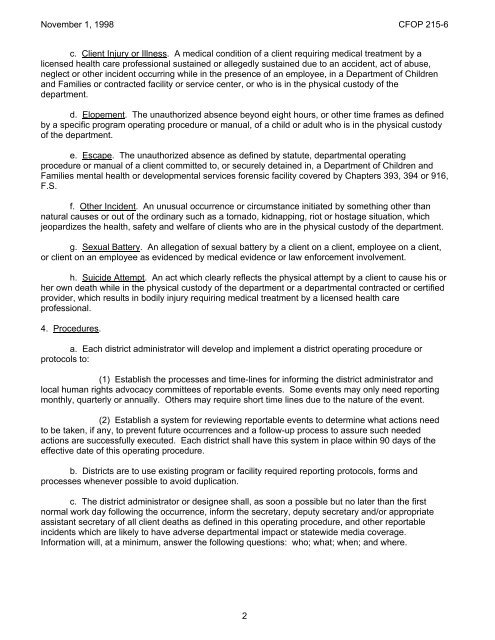CFOP 215-6 This operating procedure supersedes HRSR 215-6 ...
CFOP 215-6 This operating procedure supersedes HRSR 215-6 ...
CFOP 215-6 This operating procedure supersedes HRSR 215-6 ...
- No tags were found...
You also want an ePaper? Increase the reach of your titles
YUMPU automatically turns print PDFs into web optimized ePapers that Google loves.
November 1, 1998 <strong>CFOP</strong> <strong>215</strong>-6c. Client Injury or Illness. A medical condition of a client requiring medical treatment by alicensed health care professional sustained or allegedly sustained due to an accident, act of abuse,neglect or other incident occurring while in the presence of an employee, in a Department of Childrenand Families or contracted facility or service center, or who is in the physical custody of thedepartment.d. Elopement. The unauthorized absence beyond eight hours, or other time frames as definedby a specific program <strong>operating</strong> <strong>procedure</strong> or manual, of a child or adult who is in the physical custodyof the department.e. Escape. The unauthorized absence as defined by statute, departmental <strong>operating</strong><strong>procedure</strong> or manual of a client committed to, or securely detained in, a Department of Children andFamilies mental health or developmental services forensic facility covered by Chapters 393, 394 or 916,F.S.f. Other Incident. An unusual occurrence or circumstance initiated by something other thannatural causes or out of the ordinary such as a tornado, kidnapping, riot or hostage situation, whichjeopardizes the health, safety and welfare of clients who are in the physical custody of the department.g. Sexual Battery. An allegation of sexual battery by a client on a client, employee on a client,or client on an employee as evidenced by medical evidence or law enforcement involvement.h. Suicide Attempt. An act which clearly reflects the physical attempt by a client to cause his orher own death while in the physical custody of the department or a departmental contracted or certifiedprovider, which results in bodily injury requiring medical treatment by a licensed health careprofessional.4. Procedures.a. Each district administrator will develop and implement a district <strong>operating</strong> <strong>procedure</strong> orprotocols to:(1) Establish the processes and time-lines for informing the district administrator andlocal human rights advocacy committees of reportable events. Some events may only need reportingmonthly, quarterly or annually. Others may require short time lines due to the nature of the event.(2) Establish a system for reviewing reportable events to determine what actions needto be taken, if any, to prevent future occurrences and a follow-up process to assure such neededactions are successfully executed. Each district shall have this system in place within 90 days of theeffective date of this <strong>operating</strong> <strong>procedure</strong>.b. Districts are to use existing program or facility required reporting protocols, forms andprocesses whenever possible to avoid duplication.c. The district administrator or designee shall, as soon a possible but no later than the firstnormal work day following the occurrence, inform the secretary, deputy secretary and/or appropriateassistant secretary of all client deaths as defined in this <strong>operating</strong> <strong>procedure</strong>, and other reportableincidents which are likely to have adverse departmental impact or statewide media coverage.Information will, at a minimum, answer the following questions: who; what; when; and where.2
















